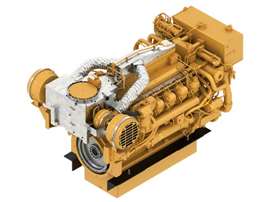Read this article in 中文 Français Deutsch Italiano Português Español
Caterpillar Marine outlines testing plans for new 3500E variant
23 May 2024
 Cat Marine dual-fuel 3516E engine (Photo: Caterpillar Marine)
Cat Marine dual-fuel 3516E engine (Photo: Caterpillar Marine)
Caterpillar Marine is to deploy the first set of field demonstrators of the 3500E marine engines in 2026. The trials will be carried out under a memorandum of understanding with Damen Shipyards Group.
Cat 3500E marine engines feature dual-fuel technology which combine proven diesel fuel systems with low-pressure (below 10 bar) fuel systems. For example, the methanol dual-fuel Cat 3500E is said to deliver 100% of the power of the existing 3500E diesel, while meeting related emissions standards.
The existing 3500E diesel is a V16 four-stroke diesel engine. Power output ranges from 2800 to 3000 bkW (3755 to 4023 bhp) at 1800 rpm.
While this engine is IMO 2 compliant, is it is anticipated that the dual-fuel variant will meet IMO 3 standards.
“We’re leveraging our deep dual-fuel expertise to help reduce emissions in the maritime industry,” said Brad Johnson, vice president and general manager of Caterpillar Marine.
“We’re expanding the 3500E platform’s fuel flexibility to provide customers with a wider array of options to navigate the energy transition,” added Andres Perez, global tug segment manager at Caterpillar Marine.
He continued: “Fuel flexibility is key to future-proofing assets. This technology will enable owners to adopt their fuel of choice when the conditions are right without having to build a new asset or face cost-prohibitive retrofits.”
The methanol dual-fuel 3516E engine is reported to use ‘the highest methanol substitution’ while meeting regulated emissions., such as formaldehyde. The plan is for the IMO 3 engine to meet the more stringent guidelines while not increasing the physical space used by aftertreatment hardware.
“Our dual-fuel Cat 3500E marine engines are optimized to achieve high methanol substitution rates over a wide range of load factors, including the low load ranges that tugs operate in most of the time,” explained Will Watson, global product director at Caterpillar Marine.
“For example, a 28-meter tug transiting at 8 knots requiring only 600 kW of propulsion power would target to achieve a methanol substitution on an energy basis above 70%. This will enable operators to reduce greenhouse gas emissions while experiencing the power and performance they’re accustomed to,” said Watson.
POWER SOURCING GUIDE
The trusted reference and buyer’s guide for 83 years
The original “desktop search engine,” guiding nearly 10,000 users in more than 90 countries it is the primary reference for specifications and details on all the components that go into engine systems.
Visit Now
STAY CONNECTED




Receive the information you need when you need it through our world-leading magazines, newsletters and daily briefings.
CONNECT WITH THE TEAM













